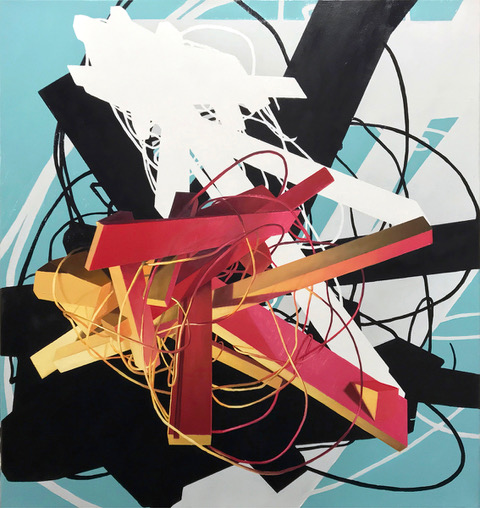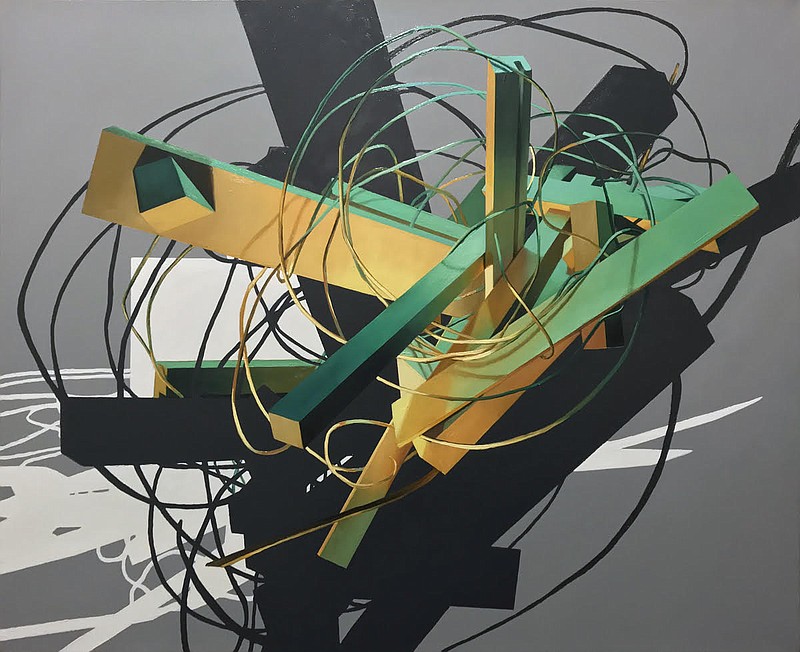 This sampling of works by Donald Keefe will be included in "Precarious Structures." He says "Untitled Construct 4" is his favorite piece in the show, citing specifically the white negative-space shape that comes from behind the form and extends toward the upper left corner. "That shape is neither a form nor a shadow, so I guess I enjoy its ambiguity," he says.
This sampling of works by Donald Keefe will be included in "Precarious Structures." He says "Untitled Construct 4" is his favorite piece in the show, citing specifically the white negative-space shape that comes from behind the form and extends toward the upper left corner. "That shape is neither a form nor a shadow, so I guess I enjoy its ambiguity," he says.Donald Keefe says he's spent a "whirlwind" three years in Tennessee since arriving to teach painting and drawing at Southern Adventist University. When he got the job offer to become assistant professor of art in the School of Visual Art & Design, he and his wife, Evangelyn were in the middle of a cross-country transition from California to Florida.
"I had honestly always thought Tennessee would be a nice place to settle," says the 33-year-old Iowa native, "and my wife had attended Southern for part of her education, so it was a natural choice to come. Since arriving, my wife and I had our first child, and it's been quite the whirlwind of events, but I think we're finally getting settled."
Settling in has given him the chance to plan an exhibition for the John C. Williams Gallery on campus. A collection of his mixed-media drawings and oil paintings will go on view Thursday. The show continues through Feb. 12.
In a news release, Keefe says he is drawn to structures that are collapsed, abandoned or under construction, and he is often inspired by the biblical story of the Tower of Babel.
If you go
* What: “Precarious Structures” by Donald Keefe.* When: Jan. 18- Feb. 12. Opening reception, 6 p.m. Jan. 18. Gallery open 8 a.m.-5 p.m. Monday-Thursday (closed noon-1 p.m. for lunch), 8 a.m.-noon Fridays and by appointment.* Where: John C. Williams Gallery, Brock Hall, Second Floor, Southern Adventist University, Collegedale.* Phone: 423-496-1814.
"Through my artwork, I seek to communicate that beauty, faith, hope and contentment can exist in life when one's support structures are weakened, confused, collapsing, being rebuilt - or being built up for the very first time," he says.
Here he answers emailed questions about the show, his career as an artist and the appearance of mourning and joy in his works. The exchange has been edited for clarity and brevity.
Q: This is your first show at Southern Adventist University. Where else have you exhibited?
A: My work has been shown in Florida, New York, Kentucky, Ohio and Alabama. I've exhibited at Manifest Gallery in Cincinnati, Ohio, The Painting Center in New York City, the Lexington Art League in Kentucky and the Catskill Art Society in Livingston Manor, New York, among others. This last summer I had two works in the Red Clay Survey at the Huntsville Museum of Art in Alabama. My work has also been published in several books and periodicals.
Q: Tell me more about how the Tower of Babel informs your work.
A: To me, the Tower of Babel story represents an innate desire for order, but also the tendency of things to fall into disorder. They built the tower for unity and security, but it became a monument to confusion and division.
Images of ruined architecture and jumbled blocks in my work suggest a tension between building up and tearing down. I cast these forms in dramatic chiaroscuro or colored light to suggest beauty, hope and, in a nod to Romanticism's use of light, the presence of the Divine.
I think that with all the hubris represented in the Tower of Babel story, we have that innate need to try to organize the rubble in our lives and build up those structures again, even if the new thing we've built for our self is precarious, missing parts or not what as they once were.
Q: Does religious imagery figure into all of your works?
A: I tend to avoid overt religious imagery. I feel that there is a saturation of these images to the point that they've come to lose their power. I attempt to convey something of my spiritual experience through the forms and subjects I relate to. I studied architectural drafting, and for a while I thought I'd be an architect, so those are the forms that I find myself returning to time and time again. That said, I think some religious imagery will always be moving - I find Caravaggio's "The Incredulity of Saint Thomas" very powerful. However, the attempt in my artwork to convey the spiritual is more akin to the Hudson River School than "church art."
Q: This show features mixed-media drawings and oil paintings. Do you use any other media for your art?
A: I do a lot of abstract nonrepresentational composition sketches in my sketchbooks. These are basically doodles, but I really think about the placement and quality of each mark. Sometimes I flesh these out into actual forms. I'd like to collect them for an exhibition some day.
Q: How many works are included in the show?
A: I should have about 15 works in the gallery. The exhibition will be a selection of works made between 2011 and 2018.
Q: How did you choose what to include?
A: There is work selected from a range of years in the show. Since the gallery is an education-oriented gallery, I wanted to have works that show the progression of an idea's development over several years of iterations. Some works are monochromatic or muted in color, others are black-and-white, some exist somewhere between drawing and painting, and others are colorful oil paintings or reference the digital tools I use in the planning stages.
I think a main division with these works is between black-and-white and color. For a few years, my work had little color and was mainly focused on architectural ruins in stark contrasts of light and shadow. In personal retrospection, I feel that, with these works, I was in mourning for the passing of my mother and father, each of whom died too young. Now, however, in my newest work, I have brought color back, and the work is beginning to verge almost on abstraction. I have a 1-year-old son, Josiah, at home who brings me much joy, and I think my re-engagement with color is because of him.
Q: At what age did you realize you wanted to be an artist?
A: Ever since I was a child. My earliest memories are of me drawing Looney Tunes characters and the family pets. I also would illustrate books I liked. My father, who was an engineer, gave me some of his books and asked me to draw from the pictures. So from an early age I was drawn to structural images and diagrams of disassembled equipment.
I started college as an anthropology major and art minor, then studied architectural drafting before finally deciding to do what I had always felt led to do, which was be a fine artist. I received my BFA from the University of Kentucky and my MFA from the University of Florida.
Contact Lisa Denton at ldenton@timesfreepress.com or 423-757-6281.
